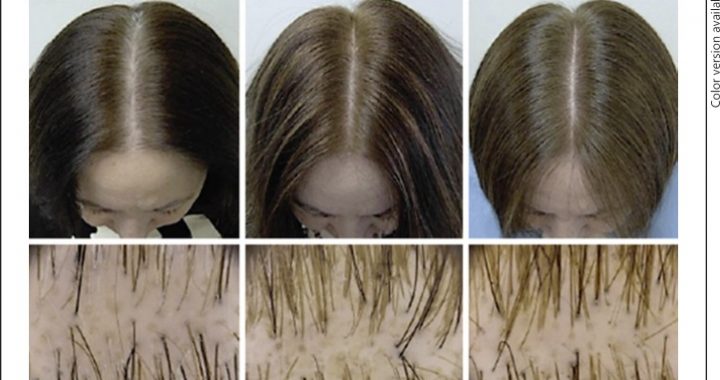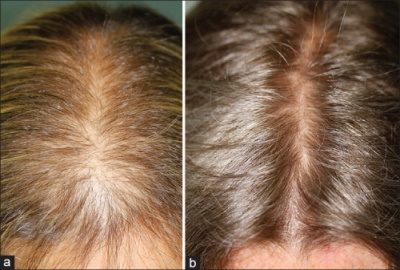Last Updated on January 3, 2021 by Robert Price
If my 35 years on earth have taught me anything, it’s this…
The female species is far more complicated and far more emotional than the male species.
If that’s a controversial statement, so be it.
Similarly, female hair loss is a more complicated and emotional subject than male hair loss.
You probably wouldn’t care that much if your husband or significant other went bald. Men lose hair. It’s the norm, and 95% of the time it’s genetic.
But female hair loss is a different animal altogether. It has an almost endless number of causes, including stress, pregnancy, and aging, just to name a few.
Female pattern hair loss is shockingly common too. About 1 in 3 women will show signs of the condition by the age of 30.
So you’re not alone, and I have good news for you in this article.
There are proven, effective treatments out there that can combat many of the 15 most common causes of female hair loss. Tread carefully though…
If you search for hair growth products on Amazon, you’ll literally find a small ocean of snake oils.
Only small number of ingredients and medications have been battle-tested and proven to combat female hair loss. Those are are treatments I’ll be talking about.
To ensure an easy reading experience, I’ve split this post into four sections.
- The 5 Proven Over-the-Counter Female Hair Loss Treatments.
- The Top 5 Prescription Drugs that Get to the Root of the Problem.
- The Two Procedures That May Be Worth Considering.
- 3 Bonus Options/Alternatives to Deal with Hair Loss.
Before I get started, let’s talk about a few of the most common reasons why women lose hair.
Your ideal treatment will depend on what type of hair loss you’re experiencing.
Common Causes of Female Hair Loss
I’ll keep this section short and to the point. A few of the most common causes of female hair loss include:
1. Genetics
Over 30 million women suffer from genetic, pattern hair loss in the United States alone.
Common, initial signs of genetic hair loss include:
- A widening part or lighter ponytail.
- Difficulty styling hair.
- An abundance of hairs falling out in the shower or on your pillow.
The Ludwig Scale for Female Pattern Hair Loss
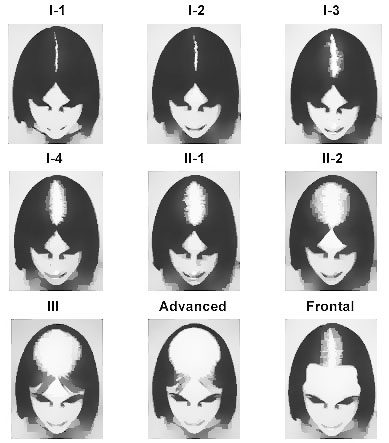
Often unnoticeable, the Ludwig L-1 pattern is the most mild form of female pattern hair loss.
2. Stress
Stress-related hair loss is quite common, especially after significant life events such as a divorce or the death of a loved one. This type of hair loss is usually temporary.
3. Hormones/Hormonal Changes
- Menopause – Roughly 50% of women experience hair loss after menopause. This can be temporary or progressive. If it’s progressive, it’s likely related to female pattern hair loss, AKA androgenic alopecia.
- Pregnancy – Post-pregnancy hair loss is very common (and temporary).
- Birth Control Pills – Certain oral contraceptives can prompt hair loss, as can discontinuing a birth-control drug.
4. Autoimmune and Hormonal Disorders
Many diseases are known to cause hair loss, including Lupus, Polycystic Ovary syndrome, and hypothyroidism, just to name a few. These types of hair loss can be difficult to manage, so it’s important to discuss your options with your doctor as well as a dermatologist or other specialist if possible.
5. Many More
For a more complete list, check out my article on the 15 most common causes of hair loss in women.
Now let’s get into the treatments.
Section 1 – The Best OTC Treatments for Female Hair Loss
Mild to moderate hair loss often responds favorably to OTC treatments such as the ones I’m about to review.
As always, you should discuss any new hair loss treatment with your doctor in advance, especially if you’re pregnant or may become pregnant.
OTC Treatment 1 – Minoxidil, AKA Rogaine or Old Reliable
It’s often the first-line of attack against female hair loss — or more specifically, female pattern hair loss.
Minoxidil has been helping people avoid premature baldness since the late 80s, or forever by hair loss treatment standards.
Pro tip: women are more sensitive to its effects than men.
The 5%, once-daily formula is currently the most popular dosage for women. 2% twice daily is similarly effective but known to cause more dermatological side effects.
Liquid or Foam?
In one of my posts, I compare the liquid and foam versions of minoxidil based on a range of factors, including price, effectiveness, and convenience.
Overall, both products work and it’s a matter of preference.
Some users with long hair have reported difficulties when applying the foam. The liquid is too greasy for others. On the plus side, the liquid is a little cheaper. Honestly, it might be worth purchasing a bottle of each and seeing which one you prefer.
How Minoxidil Works
Minoxidil works by extending the growth (anagen) phase of the hair growth cycle.
Originally used as an oral blood-pressure medication, researchers found hair growth was one its side effects. Looking to cash in on this discovery, Johnson and Johnson then liquidized the medication and began testing it. Rogaine was born and the rest is history.
Along with finasteride, minoxidil is the only FDA-approved treatment for hair loss.
Side Effects
Minoxidil is well-tolerated. The most common side effects are mild and dermatological. They include redness, skin irritation, itching, and swelling. More serious. absorptive effects have been known to occur in a small percentage of users. If you notice heart palpitations, an elevated heartbeat, or faint while using the medication, speak with your doctor as soon as possible.
Will minoxidil give me a mustache? That’s becoming a more common question.
And no, it probably won’t give you a dense, Tom Selleck-style mustache. However, hypertrichosis, hair growth in other areas of the body, is a noted side effect of minoxidil, reported in 8.9% of female users in one study.
Your unwanted hairs will stop growing if you cease treatment. Tweezers are an option too.
How Effective is Minoxidil for Female Hair Loss?
It works somewhat to very well for 60% of female users. So it’s no sure-fire solution, but it’s beneficial to the majority of users.
You may experience a shed initially when beginning a round of minoxidil treatment. This can be annoying, but it’s ultimately a good thing. Your thinning follicles are just being replaced with stronger ones.
Top Minoxidil Products for Women
Note – This article contains affiliate links, meaning I may earn a small commission if you buy a product I list on this website, at no extra cost to you. My goal is to only recommend products I’d use or recommend to a family member.
Here are a few of most highly rated minoxidil products:
- Rogaine 5% Foam for Women
- Amazon Basics 2% Liquid Minoxidil for Women
- Kirkland 5% Liquid Minoxidil for Women
OTC Treatment #2 – Laser Therapy
While light therapy is more of a supplementary treatment for male pattern baldness, it’s a first-line option in combating female hair loss. Light therapy works differently than minoxidil, by helping reinvigorate thinning hairs at the cellular level.
Using laser therapy with minoxidil may help maximize your gains.
Treatment times vary. But most likely, you’ll want to wear your laser helmet or cap for at least 30 minutes, 3 times per week.
Compliance can be an issue with laser therapy. You need to really commit to the treatment in order to see results, and it definitely doesn’t work for everyone.
Laser Therapy Studies
While laser therapy doesn’t have an extensive track record, the early research has been promising.
2014 American Journal of Clinical Dermatology Study (Laser Comb)
In a 26 week study with 128 and 141 female participants, researchers compared the effectiveness of the original laser comb vs. a sham (placebo) device. They compared the overall hair densities of the patients at baseline, then after 16 and 26 weeks.
The laser comb group had much greater gains overall. Ultimately, the researchers concluded that laser therapy may be an effective hair loss treatment option for both men and women.
One Woman’s Transformation with Laser Therapy

Much less thinning overall at the study’s conclusion.
Not all Doctors are Convinced Lasers Work
Dr.’s Pak and Rassman of the New Hair Clinic in Los Angeles both contend that in their experience, lasers don’t help regrow hair. Reviews are mixed overall among physicians. But a significant portion do recommend the therapy to their patients.
One note – It’s not an FDA-approved hair loss treatment. While many of the products on the market are “FDA-Cleared,” they’re technically not approved by the FDA for the treatment of androgenic alopecia.
When Shopping for a Laser
Pay attention to the diode count in the devices you review. Entry-level laser devices may come with 50 or so diodes. Medical-grade ones can come with 250+. More diodes should yield better and faster results, though many users have reported significant gains with entry-level products. Here are a few I like if you’re interested.
Hair Loss Daily’s Laser Therapy Picks
A medical-grade option, the Kiierr laser features over 272 diodes. It’s one of the more established brands in the industry with an excellent reputation overall.
As of winter 2020, Kierr is offering an impressive 3-year warranty with the product.
With a list price of around $1,800 (discounts are frequently available), it’s definitely not one of the cheaper products out there. But the company also offers a full line of laser devices at the official Kiierr website.
2. iRestore Laser Helmet
A budget-friendly and entry-level option, this product comes with 50 diodes. With its somewhat bulky, helmet design, it’s less desirable than the two products above aesthetically, but it’s obviously quite a bit cheaper. And reviews are pretty solid overall. You can check out the iRestore Helmet on Amazon if you’re interested.
OTC Treatment #3 – Ketoconazole Shampoo
A number of small studies have shown that the ingredient ketoconazole, an anti-fungal agent, can help mitigate hair loss. It’s not going to be as potent, most likely, as a proven treatment like minoxidil.
However, in an extensive review of 47 Ketoconazole medical articles, researchers concluded that topical ketoconazole showed promise as a low-risk supplementary or alternative treatment for AGA, pattern hair loss.
Over the course of six months, researchers tested the effectiveness of 2% minoxidil vs. a 2% ketoconazole shampoo. 40 patients participated and the study was split into two groups.
At the end of the study, they found that minoxidil worked a bit faster, but both groups saw similar gains overall. Side effects are rare with this treatment and typically limited to skin irritation and other, dermatological complaints.
Before and After (A = Baseline. D = 6 Months Later.
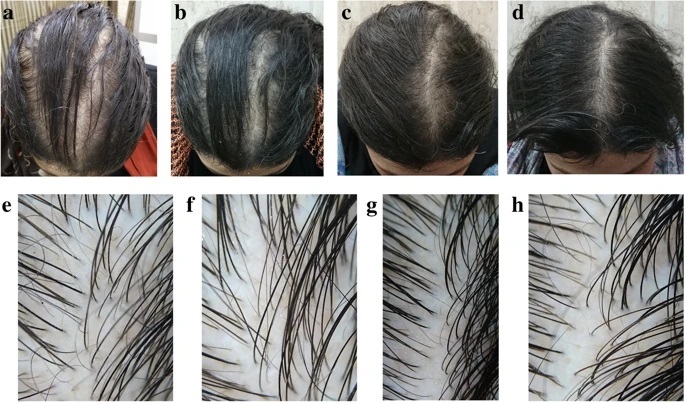
Significant gains for this patient.
Popular Ketoconazole Products
1. Nizoral Shampoo – A bit harsh for some, this is the cheapest option on the market.
2. Lipogaine Big 3 – With a volumizer to offset the ketoconazole, Lipogaine has been reported to slow hair loss and also promote hair health.
3. Revita Shampoo by DS Laboratories– Containing a variety of other ingredients that can promote hair health including caffeine and biotin, along with Ketoconazole, Revita Shampoo is another reputable product.
OTC Treatment #4 – Nanoxidil
Nanoxidil is a relatively new hair loss treatment also produced by DS labratories. The company developed their proprietary nanoxidil product, Spectral.DNC-N, as an alternative to minoxidil, which is known to cause allergic reactions and other side effects.
Minoxidil is just too harsh for some people. And as I said in the minoxidil section, women are more sensitive to its effects than men.
Chemically, nanoxidil and minoxidil are similar in many ways. But nanoxidil has a lower molecular weight and may yield less side effects as a result.
Research is limited. Minoxidil has a more substantial track record in terms of both safety and efficacy. However, a small 2019 nanoxidil showed promising results.
49 female patients used Spectral.DNC-N twice daily for 3 months. 29 continued the treatment for 3 months of further evaluation.
At the study’s conclusion, 75% of the women showed increases in hair density. Patient satisfaction rates were high and no side effects were reported.
Before and After Spectral.DNC-N
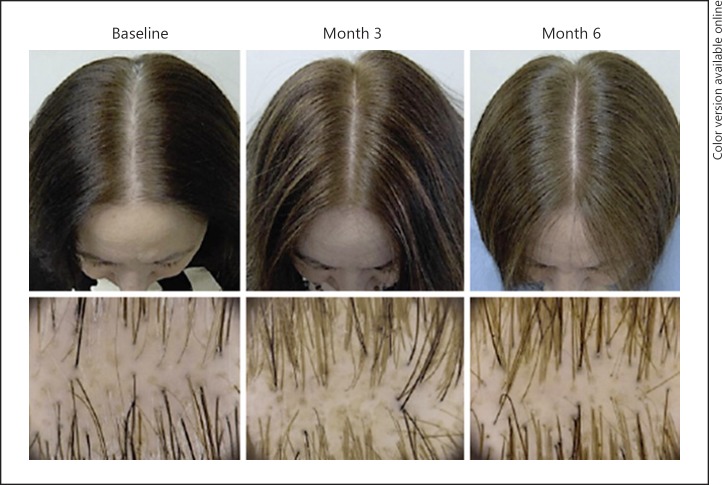
Significant gains with nanoxidil. This patient’s part line looks much stronger after 6 months of use.
Patient Satisfaction Chart (0-10 Scale)

The majority scored 8 or higher.
Other Ingredients in Spectral.DNC-N
Spectral.DNC-N also contains a variety of other products that have been shown to promote hair growth and health, including:
- Caffeine – Small studies have shown caffeine can reduce DHT, the hormone linked to pattern hair loss, in the scalp
- Azaelic Acid – Like Caffeine, Azaelic acid is believed to work as a DHT inhibitor.
- Copper peptides – Help reduce inflammation on the scalp.
My Take on Spectral.DNC-N
This may be a viable option if minoxidil doesn’t work for you, for whatever reason.
You can buy Spectral.DNC-N at their official website.
OTC Treatment #5 – Rosemary Oil
Okay, this is a natural remedy for hair loss, and it barely made the list.
But in a 2014 study, researchers found that rosemary oil was similarly effective to 2% minoxidil with less side effects overall.
However, as I noted in my in-depth rosemary oil review, there are many problems with that 2014 study.
Nevertheless, rosemary oil is one of the few natural hair-thickening remedies that isn’t a total snake oil. If you have mild hair loss, it’s a treatment that may help a little bit.
Section II – The Most Potent Prescriptions for Female Hair Loss

You’ll need to see a doctor before trying any of these treatments.
Sometimes OTC remedies just aren’t powerful enough to bring hair back.
That’s when it’s time to consider drugs — of the pharmaceutical variety, of course.
Here are five powerful prescription medications for female hair loss.
1. Birth Control Pills
Yes, some birth control pills can cause hair loss too. As I’ve said repeatedly, female hair loss is complicated.
But if you’re suffering from genetic hair loss, androgenic alopecia, then certain birth control pills could be worth a look. The brands Yaz® and Yasmin® appear to be most effective, according to the International Society of Hair Restoration Surgeons.
All women have a small number of androgens (male sex hormones) in their bodies. These androgens can cause hair loss in women prone to the condition. A hormonal therapy, oral contraceptives can help can lower your androgen levels and potentially slow or partially reverse hair loss.
Side Effects
Birth control pills can cause a wide range of side effects, including acne, sore breasts, and blood clots, to name a few. This may be a riskier treatment option for women over 35 who smoke, due to an increased risk of blood clots.
2. Spironolactone
Also used to treat high blood pressure and for edema (fluid retention), spironolactone has strong anti-androgenic properties. It can help reduce thinning and even promote regrowth at higher doses.
It’s a popular choice among women with polycystic ovary syndrome; in addition to hair loss, it can help these patients manage hirsutism (facial hair growth) and acne, two common problems associated with the condition.
Spironolactone and Minoxidil Study
In a 2018 Study, Australian dermatologist Rodney Sinclair conducted a trial using Spironolactone and oral Minoxidil for the treatment of female pattern hair loss. It was a small study with only 100 participants. However, the results were promising, showing that the patient’s on the combined therapy shed nearly 3 times less hair vs. their baseline tests.
Before and After
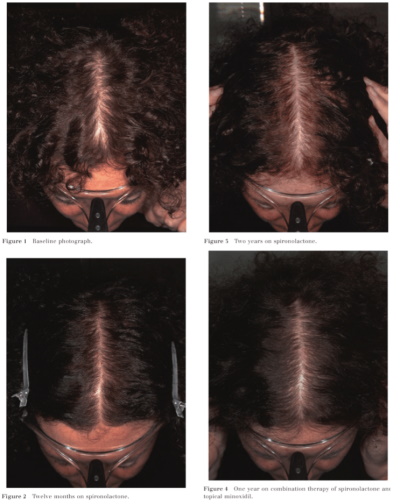
This woman’s progress was tracked over 2 years on the spironolactone/minoxidil combination. Researchers noted her significant gains initially but concluded her growth plateaued at 24 months.
Side Effects
As with any medication, a wide range of side effects are possible. Hair loss is even listed among them! Yes, it’s known to both cause and treat hair loss. It typically is beneficial for women with genetic hair loss, but it can also have the opposite effect in some cases.
Other potential side effects include:
- Hyperkalemia – high potassium levels
- Hyponatremia – Low sodium levels.
- Gynecomastia (swelling of the breasts)
- Lethargy
- Nausea/Vomiting
- Loss of interest in sex
- Leg cramps
- Be sure to discuss any and all side effects with your doctor.
3. Finasteride
While early research showed finasteride was ineffective for female hair loss, a more extensive, 2006 trial found that the drug did effectively treat the condition.
Patients in that study took finasteride at a higher dose (2.5 mg) than had been previously prescribed for male pattern baldness.
It’s rated as a Category X — drug to avoid — for women who are or might become pregnant. A potent anti-androgen, the drug can cause severe birth defects, particularly in male fetuses.
Finasteride is frequently prescribed to women with polycystic ovary syndrome, as it may help treat hair loss, along with a variety of other symptoms that accompany that condition.
As far as female hair loss treatments go, this is a somewhat controversial one. And opinions are mixed among doctors.
Some refuse to prescribe it to women. Others only prescribe it to their post-menopausal patients. And some recommend it on a case by case basis.
2006 Study
The 2006 study, mentioned above, included 112 patients and lasted for 6 months. Researchers noted the following at the study’s conclusion:
- Significant improvements in 73 patients (65.2%)
- Slight improvements in 33 patients (29.5)
- No change in 6 patients (5.4%).
Before and After
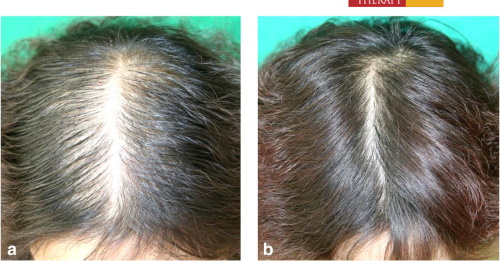
One woman’s transformation after 6 months on finasteride.
5 Milligrams May Work Even Better
In 2013, 40 post-menopausal women participated in an 18-month finasteride study, where they took 5 milligrams of the medication per day.
After 18 months, researchers concluded the following:
- 20 patients had significant improvements.
- 16 had slight gains.
- 4 saw no major gains or losses.
Finasteride was well-tolerated at the 5 mg. dose in the study. Four patients noted libido reductions but continued to take the medication in spite of that side effect. Another patient’s liver enzyme levels increased; those levels normalized on their own.
Before and After – 5 Milligrams of Finasteride
Side Effects
Check with your doctor if you notice side effects with finasteride. Sexual side effects are most common overall. Other potential side effects include chills, confusion, and dizziness. Gynecomastia, swelling of the breasts, has also been reported by users.
Overall Take
This is a potent option that can effectively combat female pattern hair loss. But it’s still somewhat controversial and not all doctors are willing to prescribe the medication to women, particularly women of child-bearing age. For more information, see my article on the 12 things women should know before considering finasteride.
4. Estrogen/Progesterone
This option is sometimes regarded as hormone replacement therapy (HRT). A variety of creams and oral medications are available — some OTC, some only via prescription.
In 2006, a Greek study tested the effectiveness of a topical estrogen cream called Estrone. It had 75 participants, all post-menopausal females.
Researchers found that 65% of the participants had improvements by the study’s conclusion. Side effects included uterine bleeding in 2 patients, as well as breast cancer in one patient. Patients with a history of breast or uterine cancer should balance the risks and benefits of this treatment with their healthcare providers.
Hormonal replacement therapy is frequently prescribed for FPHL.
5. Corticosteroids
Corticosteroids are mostly used in the treatment of alopecia areata, an autoimmune disease that causes the hair to fall out in patches.
According to the Alopecia areata foundation, new hair growth usually occurs within 4-6 weeks with this treatment, if it’s successful.
Corticosteroid injections are currently the most common treatment for the condition, even though the results aren’t permanent.
Section III – The Two Procedures That Can Help Treat Female Hair Loss
1. PRP
Known as the “Vampire” hair loss treatment, PRP uses a patient’s own blood platelets to combat hair loss. The process begins with a blood draw. The blood is spun in a large centrifuge where the platelets are isolated and put into a highly concentrated mix. That mix is then injected into the patient’s thinning areas.
PRP is expensive, with treatments starting at around $400.
It’s also a temporary remedy for hair loss. Results can reportedly last anywhere from 1 to 12 months. On the plus side, treatments can be repeated as needed and side effects/complications are rare.
This is a very operator dependent procedure. No standardized PRP protocol exists for hair loss. So be careful when selecting a PRP provider, if you elect to have the treatment.
Research is limited. But several studies have demonstrated that PRP is an effective, albeit temporary hair loss treatment. Few side effects have been reported — typically involving pain or bleeding — and it’s a well-tolerated procedure.
Over the course of three months, researchers tested the safety and efficacy of PRP for hair loss in 20 participants. There was no control (placebo) group. The team compared multiple dosages of PRP, ultimately finding the 1.5 platelets per microleter was the ideal dose. They concluded that PRP had a positive effect overall on pattern hair loss.
Before and After
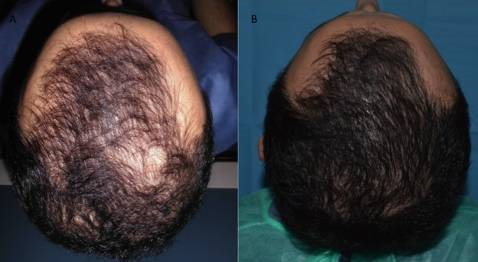
One patient’s results after 3 rounds of PRP.
2. Hair Transplantation
Hair transplants are often ill-advised for female patients.
Unfortunately, they don’t work for women as often as they do for men. That’s because women tend to experience thinning throughout their scalps, whereas balding men typically retain a stable, “permanent” zone of hair that can safely be harvested for transplantation.
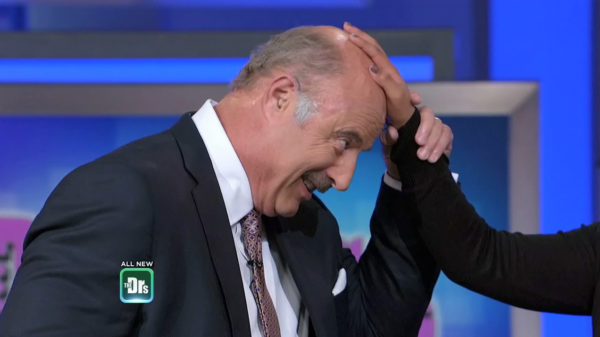
I sometimes call the male permanent zone the “Dr. Phil zone.” Even the baldest men usually have a section of hair on the sides and back of their scalps that’s resistant to DHT, the hormone that effectively causes hair loss in men and some women.
Still, even with that disclaimer, hair transplantation is a viable option for some female patients. A few of the factors that determine whether or not you’re a good candidate for transplantation may include:
- Hair density – the procedure typically works better for women with medium or coarse hair.
- Size of your hair loss area – The procedure is a better option for those with hair loss that’s limited to a particular area (for example, the hairline).
- Overall health – Other causes of hair loss, such as certain illnesses and medications, need to be discussed and evaluated in advance.
- Genetics – Does progressive hair loss run in your family? If so, other treatments should be explored first. Once your hair loss is stable, transplantation could be an option.
Hairline Lowering
Some women just aren’t happy with their natural hairlines. In those cases, especially if there is no hair loss in other areas, transplantation or a forehead-reduction procedure can yield dramatic and outstanding results.
Other Common “Fixes”
Traction alopecia, a type of hair loss caused by tight hairstyles, can lead to hair loss along the frontal region of the scalp. Hair transplantation may be an appropriate solution for this type of hair loss.
Section 4 (Bonus) – Additional Options
1. Wear a Wig/Hair System
It’s 2020. Wearing a wig is socially acceptable and even fashionable for women today.
They’re often totally undetectable.
2. Scalp Micro pigmentation
In areas where you’re thinning, you could potentially opt for scalp micropigmentation. Basically, the process involves thousands of tiny tattoos — the same color as your hair, obviously — and it can help conceal hair loss. It’s expensive and a relatively new, unregulated industry. So do your homework if you’re consider micorpigmentation.
Hair Fibers
You’ve probably seen the ads on TV. Yes, hair fiber products like Topikk and Infinity do work and work quite well as hair loss concealers. I’ll put an ad below so you can see for yourself…
Best Hair Treatments for Women – A Review
First, the OTC female hair loss treatments:
- Minoxidil – Old faithful. It works for 60% of users and can dramatically slow the progression of pattern hair loss.
- Laser Therapy – Reboot your hair follicles at the cellular level with laser therapy. Early studies have shown favorable results and it’s a well-tolerated treatment.
- Ketoconazole – An easy product to add to your arsenal, Ketoconazole may help strengthen your weakening hair follicles.
- Nanoxidil – New and somewhat unproven, a small 2019 study showed it can treat female hair loss. A potential alternative to minoxidil.
- Rosemary Oil – May help thicken hair in mild cases. Not recommended for moderate or severe hair loss.
Next, the drugs:
- Oral contraceptives – Certain birth control pills, particularly Yaz and Yasmin, can be effective options.
- Spironolactone – With strong anti-androgenic properties, Spironolactone is prescribed fairly frequently for female hair loss. It’s known to be especially useful for women with Polycystic ovary syndrome.
- Finasteride – A somewhat controversial treatment, it’s been shown to be quite effective for female hair loss. Women who are or might become pregnant must avoid it.
- Hormonal Therapy – Both estrogen and progesterone are prescribed regularly for androgenic alopecia in women.
- Corticosteroids – Mainly used to treat alopecia areata, an auto immune disease, corticosteroids can temporarily reduce hair loss in some cases.
And finally…
- Hair transplantation – Usually a last resort for women. The procedure has its place and can be beneficial, especially if a patient’s hair loss is isolated to a particular region.
- PRP – The “Vampire” hair loss treatment, this can yield outstanding albeit temporary results for some patients.
If I missed a treatment, you have an experience to share, or you have any questions, feel free to hit me up in the comment section.
Robert Price is a writer, consumer advocate, and hair loss researcher with thousands of hours of experience in the field. His goal is to keep you out of the hair loss rabbit hole, underworld, or whatever you want to call it. He founded Hair Loss Daily, the unbiased hair loss blog, in 2016. You can learn more about Robert in the my story section of this website.
